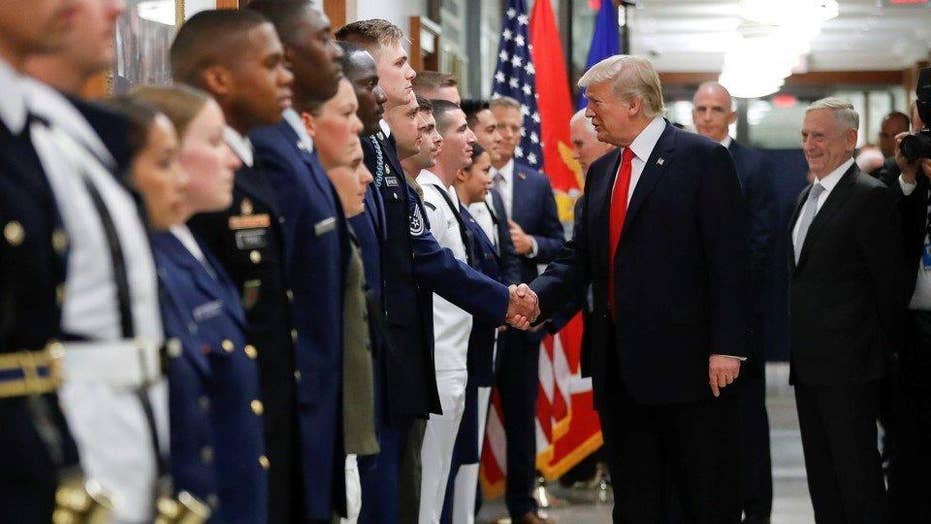Dissecting Trump's Transgender Military Policy: An Opinion Piece

Table of Contents
The Rationale Behind the Policy
The official rationale behind Trump's transgender military policy centered on purported national security concerns. However, a closer examination reveals a lack of substantial evidence supporting these claims.
National Security Concerns: A Critical Analysis
Proponents of the ban frequently cited concerns about readiness, the cost of medical care for transgender service members, and potential disruption to unit cohesion. Let's analyze these claims:
- Claims made by the Trump administration: The administration argued that allowing transgender individuals to serve would place an undue burden on military resources, disrupt unit cohesion, and compromise operational readiness. Specific claims often lacked detailed data or empirical evidence.
- Counterarguments and contradicting data: Numerous expert reports and studies countered these claims, highlighting the minimal impact of transgender service members on military readiness and the significant costs associated with discriminatory policies. Many argued that the focus on transgender service members diverted resources from more pressing military needs.
- Lack of empirical evidence: Crucially, the Trump administration failed to provide concrete evidence to support its assertions. The supposed national security risks remained largely unsubstantiated, relying heavily on anecdotal evidence and conjecture rather than data-driven analysis. This absence of evidence significantly weakened the policy's justification.
The Impact on Transgender Service Members
Trump's transgender military policy had a devastating impact on transgender service members, extending beyond mere exclusion from service.
Legal Challenges and Outcomes: Fighting for Equality
The ban faced immediate and sustained legal challenges. Cases like Doe v. Trump highlighted the unconstitutionality of the policy and the discriminatory nature of the ban.
- Key arguments in lawsuits: Plaintiffs argued that the ban violated the equal protection clause of the Fifth Amendment, discriminated based on gender identity, and lacked a rational basis. The government countered with the previously mentioned national security concerns.
- Court decisions and significance: Courts consistently ruled against the ban, citing the lack of evidence supporting the government's claims and upholding the rights of transgender individuals to serve openly. These victories were significant steps toward securing equal rights for transgender service members.
- Impact on transgender service members' lives: The legal battles, while ultimately successful, caused immense stress and uncertainty for transgender service members. Many faced the threat of discharge and experienced significant emotional and psychological distress during the protracted legal fight.
Mental and Physical Health Consequences: A Heavy Toll
The policy inflicted a considerable toll on the mental and physical health of transgender service members.
- Increased rates of anxiety, depression, and suicide attempts: Studies indicated a rise in mental health issues among transgender service members following the announcement of the ban. The uncertainty, fear of discharge, and discrimination created a highly stressful environment.
- Challenges in accessing adequate healthcare: The policy created obstacles to accessing appropriate healthcare, further exacerbating mental health challenges and impacting physical well-being.
- Ethical implications: The policy's impact on the well-being of service members raised serious ethical concerns, highlighting the moral responsibility of the government to protect the health and safety of all its citizens, including those serving in the military.
The Broader Context of LGBTQ+ Rights in the Military
Trump's transgender military policy must be understood within the broader historical context of LGBTQ+ rights in the US military.
Historical Perspective: A Step Backwards
The history of LGBTQ+ inclusion in the US military is marked by periods of progress and regression.
- Key milestones: The "Don't Ask, Don't Tell" policy, though repealed in 2010, represents a significant period of exclusion and discrimination. The repeal marked a step towards greater inclusivity before Trump’s policy reversed some of that progress.
- Trump's policy as a setback: Trump's policy represented a significant setback for LGBTQ+ rights within the armed forces, undermining years of progress towards greater inclusivity and equality.
International Comparisons: A Global Perspective
Comparing US policy with those of other countries reveals a range of approaches to transgender inclusion in the military.
- Countries with inclusive policies: Many countries have embraced inclusive policies, recognizing the value and contributions of transgender service members.
- Countries with restrictive policies: However, several countries maintain restrictive policies, reflecting varying social and political contexts.
- Impact on military effectiveness and morale: Studies suggest that inclusive policies often lead to improved military effectiveness and morale, fostering a more diverse and welcoming environment.
Conclusion
Trump's transgender military policy had detrimental effects on both individual service members and the overall military. The lack of evidence supporting national security concerns, the negative impact on morale and readiness, and the ensuing legal battles underscore the policy's flaws. The policy's legacy serves as a stark reminder of the importance of evidence-based decision-making and the need to protect the rights of all service members.
The lasting impact of Trump's transgender military policy underscores the importance of continued advocacy for inclusive policies that prioritize the rights and well-being of transgender service members. Further discussion and research on Trump's transgender military policy and its consequences are crucial to ensuring a more equitable and just future for all within the armed forces. Let's continue the conversation about the vital need for inclusive policies that respect the dignity and contributions of all members of the military, regardless of gender identity. We must work towards a future where all individuals can serve their country openly and without fear of discrimination, ensuring that Trump's transgender military policy remains a historical cautionary tale, not a blueprint for the future.

Featured Posts
-
 Potential Uk Visa Restrictions Impact On International Applicants
May 10, 2025
Potential Uk Visa Restrictions Impact On International Applicants
May 10, 2025 -
 Universitaria Transgenero Arrestada Uso De Bano Femenino Y Debate Legal
May 10, 2025
Universitaria Transgenero Arrestada Uso De Bano Femenino Y Debate Legal
May 10, 2025 -
 Lynk Lee Sau Chuyen Gioi Ngoai Hinh Xinh Dep Ban Trai Luon Sat Canh
May 10, 2025
Lynk Lee Sau Chuyen Gioi Ngoai Hinh Xinh Dep Ban Trai Luon Sat Canh
May 10, 2025 -
 Did Snls Impression Devastate Harry Styles His Reaction Revealed
May 10, 2025
Did Snls Impression Devastate Harry Styles His Reaction Revealed
May 10, 2025 -
 Nhls Top Goal Scorer Leon Draisaitl Suffers Injury
May 10, 2025
Nhls Top Goal Scorer Leon Draisaitl Suffers Injury
May 10, 2025
